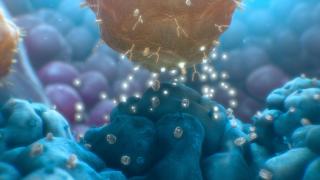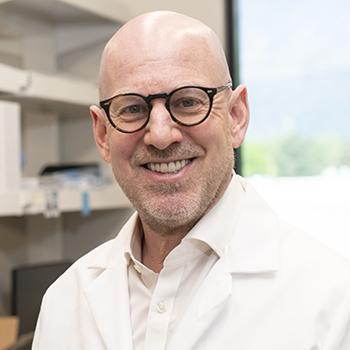You’re forgiven if you’ve never heard of nicotinamide adenine dinucleotide, or NAD. It’s hardly one of those familiar acronyms — like DNA, EKG, AIDS or COVID — that we easily recognize and understand.
And yet this complex molecule with an even more complex name really deserves wider recognition, because NAD is the central catalyst of our metabolism, which is much more than simply turning food into energy.
“Metabolism is converting everything that we eat into everything that we are and everything that we do,” said City of Hope researcher Charles Brenner, Ph.D., the Alfred E. Mann Family Foundation Chair in Diabetes and Cancer Metabolism He describes NAD as the life force that moves electrons from one molecule to another in all of these metabolic processes, allowing us to generate energy as well as build and repair every part of our bodies. Conditions that disrupt NAD disrupt our health.
NAD's Key Role
Few biochemists approach Brenner’s exhaustive understanding of NAD; it has been the focus of his research for two decades. In 2004, Brenner’s lab found a pathway to restore and rebuild NAD using nicotinamide riboside, or NR. Brenner is the chief scientific advisor of ChromaDex, which licensed and developed his NR technologies and markets an NR-based, safety-tested nutritional supplement.
A year ago, Brenner brought his expertise — and his lab — to City of Hope to chair the newly created Department of Diabetes & Cancer Metabolism. It was an ideal match, because Brenner has linked disruptions in the NAD system to models of obesity, diabetes and particular tumors. Getting to the source of the disruptions and finding ways to repair and replenish diminished NAD and/or eliminate cells with aberrant NAD regulation is what the Brenner lab does for a living. For them, it’s all NAD, all the time.
“We do things intrinsically related to NAD,” he said. “We start with its fundamental aspects, meaning its wiring diagram and regulation in normal tissues, and we pan out at the conditions that disturb NAD.”
There are many.
“In the past year,” he added, “we’ve continued to dissect diseases and conditions including cancer, diabetes, fatty liver, coronavirus infection and postpartum that dysregulate the NAD system.”
With COVID-19 for example, it’s been shown that the body’s first line of defense, the innate immune system — generates an interferon response. Brenner’s group showed that coronavirus’s induction of interferons leads to an attack on the NAD system that may underlie the way interferons and viral infection make people feel miserable. They further showed that cells with higher NAD status were able to dampen the replication of model coronaviruses in culture.
“This led to studies here and in Europe,” he continued, “in which NR combined with several metabolic activators led to accelerated recovery time in mild to moderate COVID cases.” Further studies are examining NR alone as a possible COVID-19 prevention and treatment.
Because Zika, herpes and other viruses also induce interferons and attack cellular NAD, Brenner believes this approach may be broadly antiviral. “In our lab,” he says, “we don’t consider higher NAD status a panacea, but if we see NAD under attack in a disease, there’s a good chance that boosting NAD will be helpful.”
The lab is also examining the effect of NR in fatty liver disease and neurodegenerative conditions. Brenner’s team has detected powerful activities in mouse models, which has led to dozens of human clinical trials.
Another animal study has shown the benefits of boosting NAD in new mother mice and rats, benefits which extended to their offspring into adulthood. “A new mom is stressed, and you can measure that stress level in terms of her liver’s NAD system,” Brenner explained. “A new mother’s liver is working overtime to mobilize nutrients to the mammaries for milk production. A boost of NAD leads to the production of more milk, higher quality milk, and offspring that are neurodevelopmentally advanced.”
The Cancer Link
When it comes to cancer, Brenner points out that, like any other cells, tumors need NAD. However, Brenner and others have determined that many tumors have a fragile NAD system. Identifying such tumors better enables them to be targeted and destroyed. It “makes them vulnerable to biomarker-informed targeting of particular NAD pathways. We think we can exploit that. This is our main cancer project,” he said.
Brenner brings a sophisticated passion to each of his projects, but he saves his choicest words for people who claim that aging is understood, or can be halted or reversed.
“Sadly, such anti-aging promises have been made since time immemorial — they are not evidence-based, are profoundly misleading and exploitative,” he says.
Because of the interface between NAD metabolism and the biology of aging, Brenner has become active in the public arena and is known to challenge people on Twitter who claim that we “don’t have to age.” “I’m determined to separate fact from fiction in the aging space,” he says.
“Look, aging is inevitable,” he continued. “But we can age better. More and more of us are going to live to be 100 and, with the right clinical trials, we may be able to demonstrate improved repair and resiliency with NR supplementation. But those who say they found longevity genes and can stop the aging process are telling tall tales.”
Overall, Brenner says it’s been a busy first year, complicated by the pandemic, which made it a bit more challenging to transfer his lab to City of Hope. Nevertheless, he is very happy with his hires thus far, and he’s optimistic about the future. “Our laboratory will continue to dissect the mechanisms by which we can kill tumor cells and support normal tissue functions by modulating NAD,” he promised.
And one year into his City of Hope tenure, Brenner sees his mission and the institution’s as one: to bring real hope through real science to more people. As he explained at a recent gathering:
“We’re doing the research at City of Hope to help you build resiliency, age better, diagnose cancer more precisely to enable treatment, and to help people live free of the burdens of fatty liver and diabetes. We’re here to empower people the world over to better understand metabolism science, but we’re not going to fill people up with false hopes and promises.”

